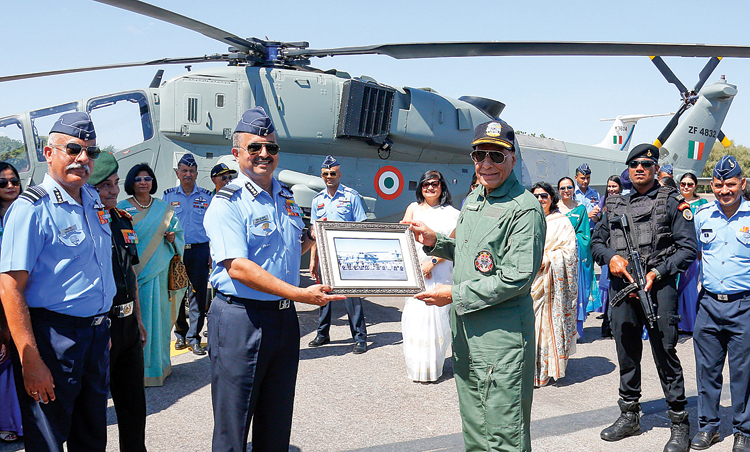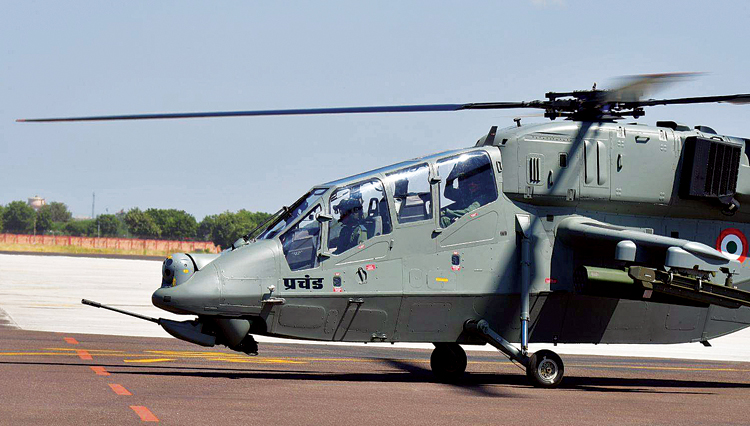INDIAN ARMED FORCES CHIEFS ON OUR RELENTLESS AND FOCUSED PUBLISHING EFFORTS

The insightful articles, inspiring narrations and analytical perspectives presented by the Editorial Team, establish an alluring connect with the reader. My compliments and best wishes to SP Guide Publications.

"Over the past 60 years, the growth of SP Guide Publications has mirrored the rising stature of Indian Navy. Its well-researched and informative magazines on Defence and Aerospace sector have served to shape an educated opinion of our military personnel, policy makers and the public alike. I wish SP's Publication team continued success, fair winds and following seas in all future endeavour!"

Since, its inception in 1964, SP Guide Publications has consistently demonstrated commitment to high-quality journalism in the aerospace and defence sectors, earning a well-deserved reputation as Asia's largest media house in this domain. I wish SP Guide Publications continued success in its pursuit of excellence.
- A leap in Indian aviation: Prime Minister Modi inaugurates Safran's Global MRO Hub in Hyderabad, Calls It a Milestone
- All about HAMMER Smart Precision Guided Weapon in India — “BEL-Safran Collaboration”
- India, Germany deepen defence ties as High Defence Committee charts ambitious plan
- True strategic autonomy will come only when our code is as indigenous as our hardware: Rajnath Singh
- EXCLUSIVE: Manish Kumar Jha speaks with Air Marshal Ashutosh Dixit, Chief of Integrated Defence Staff (CISC) at Headquarters, Integrated Defence Staff (IDS)
- Experts Speak: G20 Summit: A Sign of Global Fracture
‘Prachanda’ Marks its Entry into IAF
The Defence Minister formally inducted indigenously designed and developed LCH, uplifting the self-reliant defence industry

Ahead of the DefExpo 2022, a big boost to Atmanirbharata in Defence has been displayed as the air force adds indigenous prowess. The Indian Air Force (IAF) inducted the indigenously designed and developed Light Combat Helicopter (LCH) on Monday in Jodhpur. Defence Minister Rajnath Singh presided over the formal induction of the LCH, designed and developed by Hindustan Aeronautics Limited (HAL). Naming LCH as “Prachanda” (fierce), Defence Minister said that its induction comes during the Amrit kal when the Nation is celebrating Azadi ka Amrit Mahostav and a pointer to the future when IAF will be the top most force in the world, as also making the country fully Atmanirbhar in Defence production requirements. Shortly after the induction, Defence Minister also took a sortie onboard the LCH.
The induction of LCH ‘Prachanda’ is a special moment for the collective resolve of 130 crore Indians to make our nation strong and self-reliant in the defence sector. Congratulations to every Indian! https://t.co/KEGe7aXPmL
— Narendra Modi (@narendramodi) October 3, 2022
In his address, the Defence Minister appreciated the role of IAF in meeting internal as well as external threats to the country since independence. He added that the induction of LCH, with its tremendous power and versatility, not only enhances the combat capabilities of IAF but is also a big step towards selfreliance in defence production, as envisioned by Prime Minister Narendra Modi. The trust reposed and support extended by the IAF towards indigenous design & development is evident through the examples such as Marut, Light Combat Aircraft, Akash missile system, Advanced Light Helicopter and the Light Combat Helicopter. “The induction of LCH underlines the fact that just as the country trusts the Indian Air Force, the IAF equally trusts the indigenous equipment,” he added.
The need for such helicopters was felt during the Kargil War in 1999, and that is when the LCH was incepted. A homegrown lightweight assault helicopter that could hold precision strikes in all Indian battlefield scenarios was required and the project was sanctioned in 2006 and HAL was chosen to develop the LCH. Following two decades of R&D and indigenous efforts in that direction, the LCH is finally here. The LCH was formally inducted into the Indian Army on September 29 at Bengaluru and now into the IAF. Out of the 15 of these choppers, whose procurement was approved by the government, 10 are for the IAF and five for the Army.
“The LCH was flying not only on the strength of its rotors, engines and blades, but also on the strength of penance, patience, dedication and patriotism of many scientists, engineers and others.” Irrespective of the time taken, the LCH promises to meet the requirements of modern warfare and necessary quality parameters under varied conditions of operations. It is capable of self-protection, of carrying a wide variety of ammunition, and delivering it to the field quickly. “This versatile helicopter perfectly meets the needs of our armed forces in various terrains and as such LCH is an ideal platform for both our Army and Air Force,” the Minister added.
Air Chief Marshal V.R. Chaudhari, Chief of Air Staff said that induction of LCH adds unique capability to the IAF’s combat potential. “Versatility and offensive potential of the LCH is at par or better than most attack helicopters operating globally. Selection of the personnel in the 143-helicopter unit which will man the LCH have been made based on professional competence so as to ensure operationalisation of the unit at the earliest,” he added.

The LCH is the first indigenous Multi-Role Combat Helicopter designed and manufactured by HAL. It has potent ground attack and aerial combat capability. Inducted in IAF’s newly raised No. 143 Helicopter Unit, Dhanush, the twinengine LCH stands as a testimony to India’s growing prowess in indigenous design, development & manufacturing and hence a significant milestone in the path towards ‘Atmanirbharta’ in Defence. The helicopter possesses modern stealth characteristics, robust armour protection and formidable night attack capability.
Onboard advanced navigation system, guns tailored for close combat and potent air to air missiles make the LCH especially suited for the modern battlefield. Capable of operating from high altitude terrain and carrying out precision strikes at high altitude targets, the helicopter is a formidable addition to IAF’s arsenal. The makers boast LCH to be the only attack helicopter in the world which can land and take off at an altitude of 5,000 meters with a considerable load of weapons and fuel, meeting the specific requirements laid out by the Indian Armed Forces. LCH comes with the maximum take-off weight of 5.8 tonnes, maximum speed of 268 kilometers per hour, range of 550 kilometers, endurance of over three hours and service ceiling — the maximum density altitude to which it can fly — of 6.5 kilometres. Two French-origin Shakti engines manufactured by the HAL power the LCH.
The recent conflicts in Ukraine and elsewhere showed us that heavy weapon systems and platforms, which do not allow for rapid movement in the battlefield, are sometimes vulnerable and become easy targets for the enemy, Singh said. He further added that therefore, the need of the hour is to move towards the development of those equipment and platforms, which are mobile, have ease of movement, are more flexible, and at the same time meet the requirements of the armed forces. In this context, LCH has been developed with an unprecedented balance of all these features and HAL should be congratulated for this.
“LCH was proposed to meet IAF’s requirement of a dedicated light helicopter for combat operations. LCH has maximum possible commonality with ALH,” states HAL. LCH with a narrow fuselage has pilot and co-pilot/gunner in tandem configuration incorporating a number of stealth features, Armour protection, Night attack capability and crash worthy landing gear for better survivability.
The major features of LCH are:
- Glass Cockpit
- Crashworthy bottom structure
- Crashworthy fixed tricycle type with tail wheel landing gear
- Canted flat panels for low Radar Cross Section
- Integrated Dynamic System
- Hinge less Main Rotor / Bearing less Tail Rotor
- Anti-Resonance Isolation System
- Integrated Architecture and Display System (IADS)
- IR Suppressor
- Counter Measuring Dispensing System (CMDS)
- EO pod, Helmet Mounted Display System & EW suite
- 20mm Gun, 70mm Rocket & Missiles
- Air to Air Missiles (ATAM)
- Air to Ground Missiles (ATGM).





